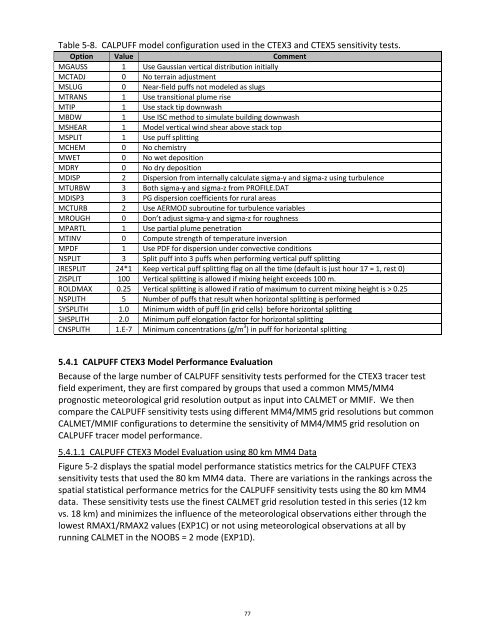Documentation of the Evaluation of CALPUFF and Other Long ...
Documentation of the Evaluation of CALPUFF and Other Long ...
Documentation of the Evaluation of CALPUFF and Other Long ...
Create successful ePaper yourself
Turn your PDF publications into a flip-book with our unique Google optimized e-Paper software.
Table 5‐8. <strong>CALPUFF</strong> model configuration used in <strong>the</strong> CTEX3 <strong>and</strong> CTEX5 sensitivity tests.<br />
Option Value Comment<br />
MGAUSS 1 Use Gaussian vertical distribution initially<br />
MCTADJ 0 No terrain adjustment<br />
MSLUG 0 Near‐field puffs not modeled as slugs<br />
MTRANS 1 Use transitional plume rise<br />
MTIP 1 Use stack tip downwash<br />
MBDW 1 Use ISC method to simulate building downwash<br />
MSHEAR 1 Model vertical wind shear above stack top<br />
MSPLIT 1 Use puff splitting<br />
MCHEM 0 No chemistry<br />
MWET 0 No wet deposition<br />
MDRY 0 No dry deposition<br />
MDISP 2 Dispersion from internally calculate sigma‐y <strong>and</strong> sigma‐z using turbulence<br />
MTURBW 3 Both sigma‐y <strong>and</strong> sigma‐z from PROFILE.DAT<br />
MDISP3 3 PG dispersion coefficients for rural areas<br />
MCTURB 2 Use AERMOD subroutine for turbulence variables<br />
MROUGH 0 Don’t adjust sigma‐y <strong>and</strong> sigma‐z for roughness<br />
MPARTL 1 Use partial plume penetration<br />
MTINV 0 Compute strength <strong>of</strong> temperature inversion<br />
MPDF 1 Use PDF for dispersion under convective conditions<br />
NSPLIT 3 Split puff into 3 puffs when performing vertical puff splitting<br />
IRESPLIT 24*1 Keep vertical puff splitting flag on all <strong>the</strong> time (default is just hour 17 = 1, rest 0)<br />
ZISPLIT 100 Vertical splitting is allowed if mixing height exceeds 100 m.<br />
ROLDMAX 0.25 Vertical splitting is allowed if ratio <strong>of</strong> maximum to current mixing height is > 0.25<br />
NSPLITH 5 Number <strong>of</strong> puffs that result when horizontal splitting is performed<br />
SYSPLITH 1.0 Minimum width <strong>of</strong> puff (in grid cells) before horizontal splitting<br />
SHSPLITH 2.0 Minimum puff elongation factor for horizontal splitting<br />
CNSPLITH 1.E‐7 Minimum concentrations (g/m 3 ) in puff for horizontal splitting<br />
5.4.1 <strong>CALPUFF</strong> CTEX3 Model Performance <strong>Evaluation</strong><br />
Because <strong>of</strong> <strong>the</strong> large number <strong>of</strong> <strong>CALPUFF</strong> sensitivity tests performed for <strong>the</strong> CTEX3 tracer test<br />
field experiment, <strong>the</strong>y are first compared by groups that used a common MM5/MM4<br />
prognostic meteorological grid resolution output as input into CALMET or MMIF. We <strong>the</strong>n<br />
compare <strong>the</strong> <strong>CALPUFF</strong> sensitivity tests using different MM4/MM5 grid resolutions but common<br />
CALMET/MMIF configurations to determine <strong>the</strong> sensitivity <strong>of</strong> MM4/MM5 grid resolution on<br />
<strong>CALPUFF</strong> tracer model performance.<br />
5.4.1.1 <strong>CALPUFF</strong> CTEX3 Model <strong>Evaluation</strong> using 80 km MM4 Data<br />
Figure 5‐2 displays <strong>the</strong> spatial model performance statistics metrics for <strong>the</strong> <strong>CALPUFF</strong> CTEX3<br />
sensitivity tests that used <strong>the</strong> 80 km MM4 data. There are variations in <strong>the</strong> rankings across <strong>the</strong><br />
spatial statistical performance metrics for <strong>the</strong> <strong>CALPUFF</strong> sensitivity tests using <strong>the</strong> 80 km MM4<br />
data. These sensitivity tests use <strong>the</strong> finest CALMET grid resolution tested in this series (12 km<br />
vs. 18 km) <strong>and</strong> minimizes <strong>the</strong> influence <strong>of</strong> <strong>the</strong> meteorological observations ei<strong>the</strong>r through <strong>the</strong><br />
lowest RMAX1/RMAX2 values (EXP1C) or not using meteorological observations at all by<br />
running CALMET in <strong>the</strong> NOOBS = 2 mode (EXP1D).<br />
77

















